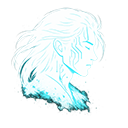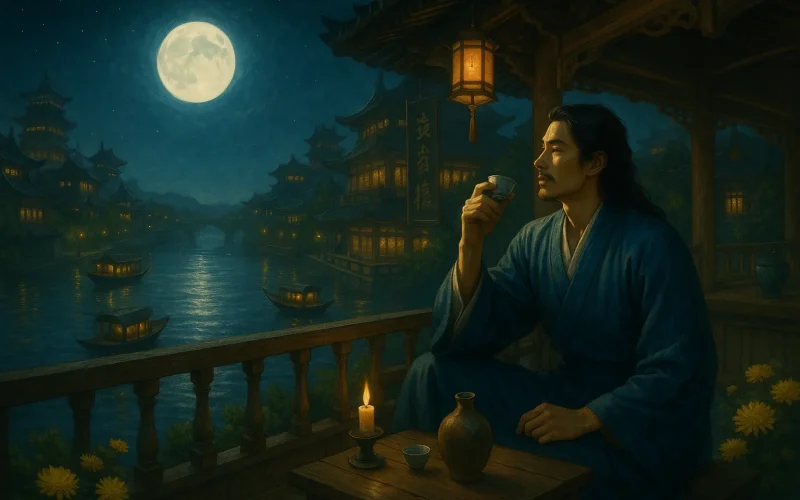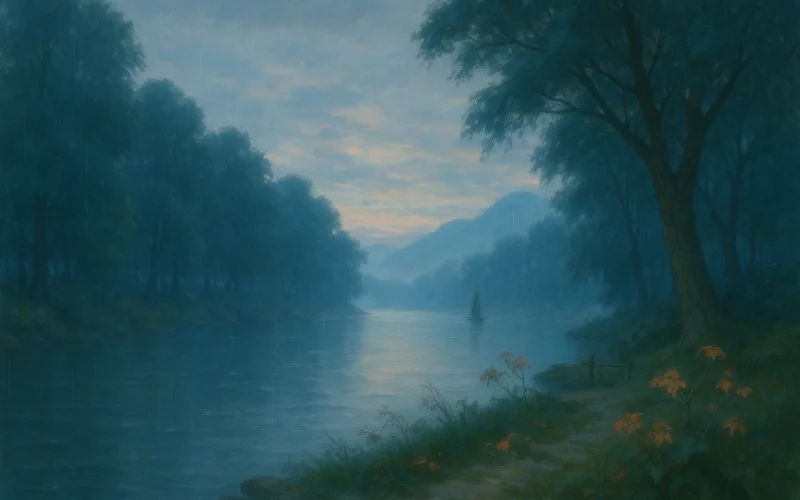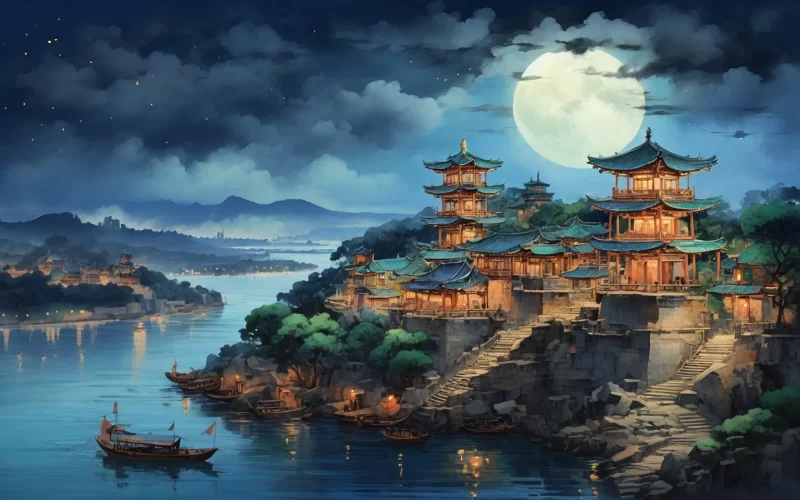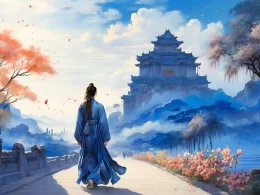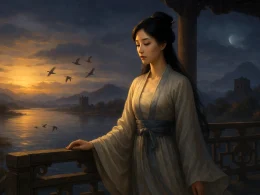Last year this night, drunk under blooms and moon’s bright face,
This night by river, moon dims dyke and willows veil the boat’s space.
Where is my old friend now?
Take my sorrows down the river’s flow.
Next year before flowers,
Again I’ll remember last year’s hours.
Original Poem
「减字木兰花 · 去年今夜」
吕本中
去年今夜,同醉月明花树下。
此夜江边,月暗长堤柳暗船。
故人何处?带我离愁江外去。
来岁花前,又是今年忆去年。
Interpretation
Penned during the mid-Northern Song period, this lyric by Lü Benzhong distills the essence of farewell into crystalline temporal layers—"last year," "this year," "next year"—creating a triple-exposure of memory, solitude, and foreboding. Set along moonlit riverbanks, its restrained language and cyclical structure embody the Confucian literati's elegant sorrow, where unspoken grief resonates more profoundly than lament.
First Stanza: "去年今夜,同醉月明花树下。此夜江边,月暗长堤柳暗船。"
Qùnián jīnyè, tóng zuì yuè míng huā shù xià. Cǐ yè jiāng biān, yuè àn cháng dī liǔ àn chuán.
Last year this night—
drunk together under moonlit blossoms.
Tonight by the river:
dim moon on long embankment,
willows shading darkened boats.
The stanza pivots on stark contrasts: last year's luminous communion ("moonlit blossoms") versus this year's obscured solitude ("dim moon," "darkened boats"). The visual chiaroscuro—bright then shadowed—externalizes the poet's inner shift from shared joy to isolated melancholy, with the willow-shaded boat symbolizing both mooring and departure.
Second Stanza: "故人何处?带我离愁江外去。来岁花前,又是今年忆去年。"
Gùrén héchù? Dài wǒ lí chóu jiāng wài qù. Lái suì huā qián, yòu shì jīnnián yì qùnián.
Where now, old friend?
Carry my parting sorrow beyond the river.
Next year before flowers—
again I'll recall last year
as I do this year.
The rhetorical "Where now?" (故人何处) hangs unanswered, amplifying absence. The plea to "carry sorrow beyond the river" (离愁江外去) personifies grief as a tangible burden, while the closing temporal loop ("recall last year/as I do this year") traps the poet in perpetual recurrence—a psychological eddy where memory and anticipation blur.
Holistic Appreciation
This lyric's power lies in its nested chronology. The first stanza's juxtaposition—last year's shared radiance versus this year's solitary gloom—establishes irreparable loss. The second stanza projects this pattern forward: next year's flowers will only renew this year's loneliness, completing a cycle of eternal return. Spatial expansion ("beyond the river") contrasts with temporal circularity, mirroring how geographical distance exacerbates emotional stasis.
Traditional imagery (moon, willows, boats) gains fresh urgency through Lü's minimalist handling. The moon's dimming traces fading hope; the "darkened boat" (暗船) suggests journeys suspended between memory and reality. Such economy epitomizes Song lyricism—where a single character (暗, "dim") conveys volumes.
Artistic Merits
- Temporal Spiral
The three-tiered timeframe ("last/this/next year") creates a poetic Möbius strip, where past and future fold into present grief. - Luminary Symbolism
The moon's transition from "bright" (明) to "dim" (暗) charts emotional entropy, while willows (柳)—emblems of parting—deepen the nocturne's melancholy. - Kinetic Stillness
The "darkened boat" (暗船) visually anchors the poem, its unmooring implied rather than shown—a masterstroke of narrative restraint. - Cyclical Syntax
The closing line's recursive structure ("again…as I do") linguistically enacts the inescapability of memory.
Insights
Lü's lyric reveals how farewells fracture time. The "last year" that feels immediate yet irretrievable, the "next year" that promises only renewed longing—such temporal collapses mirror the Confucian dilemma: how to reconcile ethical permanence with life's impermanence. The poem's ultimate wisdom lies in its quiet acceptance of recurrence; by naming the cycle ("again I'll recall"), the poet masters it. For modern readers, it models how to hold joy and grief in tandem—as phases of the same moon.
About the Poet
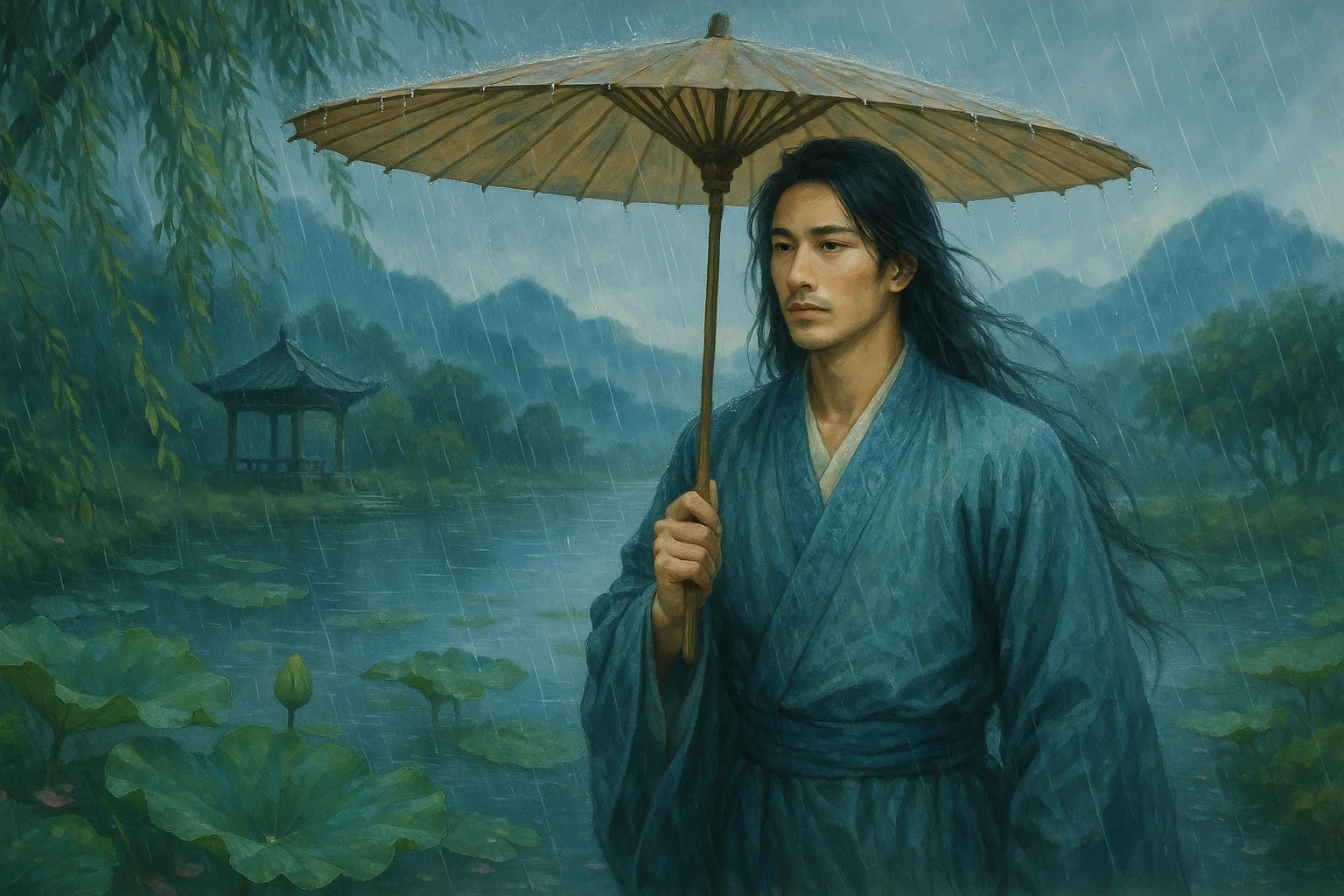
Lü Benzhong (吕本中 1084 - 1145), a native of Shouxian in Anhui, was a renowned poet and Neo-Confucian scholar of the Southern Song Dynasty. As a key theorist of the Jiangxi Poetry School, he proposed the concept of "living method" (huofa), advocating for natural variation within established poetic rules. With over 1,270 surviving poems, his Genealogy of the Jiangxi Poetry School (Jiangxi Shishe Zongpai Tu) established Huang Tingjian as the school's patriarch, profoundly influencing Song poetic theory and serving as a bridge between the Jiangxi School and the Four Masters of the Mid-Song Revival.

